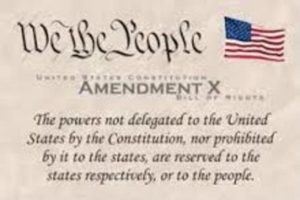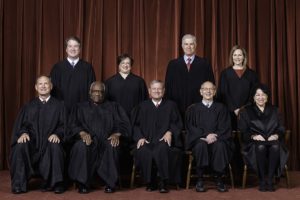Jan
9
What’s at Stake in the Dobbs v. Jackson Abortion Case
“While the line of questions posed by the conservative members of the Court were encouraging, a lot can happen in the next few months to alter opinions. I do not believe this current administration will tolerate any decision in the case that favors the pro-life side, especially if it undermines Roe.” — Troy Newman, President of Operation Rescue
It has been over a month since oral arguments were heard by the Supreme Court of the United States (SCOTUS) on Dobbs v. Jackson Women’s Health Organization, which focuses on a 2018 Mississippi law that prohibits abortion after 15 weeks gestation. It is a very important case for a number of reasons, so I thought it worth reviewing…

Like Mississippi Attorney General Lynn Fitch before him, Scott G. Stewart, Solicitor General for the State of Mississippi, argued that both Roe v. Wade (1973) and Planned Parenthood v. Casey (1992) were bad jurisprudence, wrongly decided by SCOTUS, and should be tossed aside. The U.S. Constitution doesn’t address abortion and should thus be left to the individual states. As per the Tenth Amendment, “The powers not delegated to the United States by the Constitution, nor prohibited by it to the States, are reserved to the States respectively, or to the people.”
On the other side of the aisle, Julie Rikelman of the Center for Reproductive Rights argued that the Fourteenth Amendment’s liberty clause (not the privacy clause) disallows such restrictions on abortion, which would cause undue burden on the mother. That is, denying an abortion would violate the woman’s “liberty rights” to end her pregnancy. Obviously, the JWHO and its counsel claims that the Mississippi law in question fails this “undue burden” test.
Interestingly, the Biden Administration also got to chime in, as represented by Elizabeth Prelogar, the former Assistant Special Counsel to Robert Mueller during the failed Russian Collusion investigation against President Trump. Prelogar predicted grave harm should Roe be overturned, citing the 10% failure rate of contraception as constituting a “need” for abortion. (Odd, since Planned Parenthood is always touting the effectiveness of contraceptives in preventing the need for abortion.)
I recently listened to a podcast interview between Greg Koukl (Stand to Reason) and Scott Klusendorf (Life Training Institute), in which they discussed the case and its implications. One of the points that they made is that, contrary to how some have framed the case, this is neither a religious nor political issue. It isn’t an effort to overturn precedent in order to satisfy one political party (or an influential constituency within). Rather, this is a legal and judicial issue.

Some say the matter shouldn’t be politicized but left with the Court instead. As Klusendorf point out, the irony is that the Court(s) that ruled in Roe and Casey were legislating from the bench by injecting their own political biases into the judicial process. Oddly enough, others want to keep Roe in force in order to keep the federal government out of the abortion issue, when the effect of Roe was precisely to give one branch of the federal government all the power on the issue.
“Roe v. Wade basically co-opted the issue from the people and said the federal courts alone will decide this issue. The legislative and executive branches have no say whatsoever. So, now, if the court sends this back to the states by reversing Roe and Casey, we the people will have a chance to have our voice heard….”
So, as demonstrated by Dobbs’ counsel, the goal for this case is to remove bad law and put legislative authority back in the appropriate hands. According to Klusendorf, the key question being debated is, “Can states limit abortion before fetal viability?” That’s it.
With that said, no one is denying the fact that reversing Roe and Casey would be a huge step in the right direction for the pro-life agenda. As Klusendorf said,
“[Then] we can pass much tougher abortion laws than what we currently see. I mean, right now, what we see are basically abortion control legislation, which, given what we’re up against, is the best good we can do. But, we want to go far, far beyond that. We want every child protected from conception forward. And that’s going to mean we’ve got to get rid of Roe v. Wade and Planned Parenthood v. Casey, which stand in the way of that.”
On the other hand, the federal government does have a constitutional role in regards to unborn children, and that is to protect the natural rights — beginning with the lives — of its citizens. These “natural rights” are those accorded people by virtue of being human beings, rather than rights granted by a political body (e.g., voting in a nation’s elections). The humanity (and personhood) of the unborn is unassailable, as I have argued elsewhere (using facts and rationale I got from Koukl, Klusendorf, and others).
SCOTUS’ decision on the case will likely not be made and released until late June 2022. The current makeup of the Court is not as consistently, juridically conservative as Klusendorf (or I) would like, so the outcome could go either way. In fact, Klusendorf laid out four possibilities. The Court could:

1) strike down the Mississippi law and (re)affirm Roe and Casey (“I don’t think many justices want to do [this], because they recognize how bad these decisions are. They are precisely what the other side is saying we shouldn’t do; they are politicized decisions.”)
2) get rid of Roe and Casey to uphold a state’s ban on abortion that bans the procedure before viability
3) replace fetal viability with another standard (consciousness? concept of self?), which just creates another mess, as it will be as arbitrary as the last
4) move the viability line (based on current technology, 19-21 weeks?), but then they have to either strike down the Mississippi law or somehow rewrite it to make it comply with the new standard
Koukl pointed out that even a less-than-optimal ruling that still moves the line back earlier than 24 weeks (as set in Casey) will allow states to save more babies, while possibly also setting the stage for additional progress against Roe. Klusendorf, on the other hand, believes that if this case doesn’t result in the reversal/gutting of Roe and Casey, it could be many years until another suitable case presented itself, and meanwhile political conservatives who want a rule of law government will be incredibly demoralized. They will see that electing pro-life presidents (who then appoint conservative judges/justices) does little good, and many will be so shattered as to withdraw from politics altogether. That would be a setback for the pro-life movement, but it would be a disaster for the rule of law.
Klusendorf agrees with the legal experts that think only the first two possibilities above are realistic, and he remains cautiously optimistic (or “hopeful”) for #2. If he is correct, the individual states can act immediately, and many already have “trigger laws” in place to kick in as soon as federal courts no longer have authority regarding abortion. Of course, that goes both ways, and Klusendorf thinks we might see maybe 20 red states with strongly pro-life laws and maybe another 20 blue states with equally strong pro-abortion laws. (He didn’t mention the other ten.)
Bottom line, though, is that there would no longer be unconstitutional federal law controlling what states can do on such a major issue within their own jurisdiction. That’s a good thing, and it would not only help preserve the rule of law in this nation but save many innocent lives, as well.















